Related Research Articles
The Cranbourne line is a commuter rail service operated by Metro Trains Melbourne in the south-eastern suburbs of Melbourne, Victoria, Australia. It operates along the inner section of the former South Gippsland line. The service is part of the Public Transport Victoria metropolitan train network.

The Dartmouth Steam Railway, formerly known as the Paignton and Dartmouth Steam Railway, is a 6.7-mile (10.8 km) heritage railway on the former Great Western Railway branch line between Paignton and Kingswear in Devon, England. Much of the railway's business is from summer tourists from the resorts of Torbay, who travel to Kingswear, where the Dartmouth Passenger Ferry takes them across the River Dart to Dartmouth.

The Cumbrian Coast line is a rail route in North West England, running from Carlisle to Barrow-in-Furness via Workington and Whitehaven. The line forms part of Network Rail route NW 4033, which continues via Ulverston and Grange-over-Sands to Carnforth, where it connects with the West Coast Main Line.
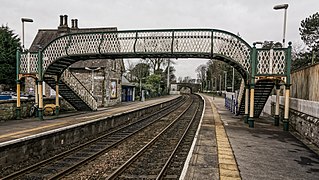
Cark & Cartmel is a railway station on the Furness line, which runs between Barrow-in-Furness and Lancaster. The station, situated 15+1⁄4 miles (25 km) north-east of Barrow-in-Furness, serves the villages of Allithwaite, Cark, Cartmel and Flookburgh in Cumbria. It is owned by Network Rail and managed by Northern Trains.

New Lane railway station serves the town of Burscough in West Lancashire, in England. It is served and managed by Northern Trains and is situated near the Martin Mere bird sanctuary, which can be reached by a 1-mile walk.

Wigan North Western railway station is one of two railway stations serving the town centre of Wigan, Greater Manchester, England.
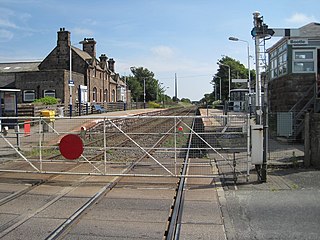
Bootle is a railway station on the Cumbrian Coast Line, which runs between Carlisle and Barrow-in-Furness. The station, situated 24 miles (39 km) north-west of Barrow-in-Furness, serves the village of Bootle in Cumbria. It is owned by Network Rail and managed by Northern Trains.
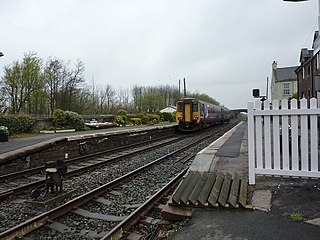
Drigg is a railway station on the Cumbrian Coast Line, which runs between Carlisle and Barrow-in-Furness. The station, situated 31 miles (50 km) north-west of Barrow-in-Furness, serves the villages of Drigg and Holmrook in Cumbria. It is owned by Network Rail and managed by Northern Trains.
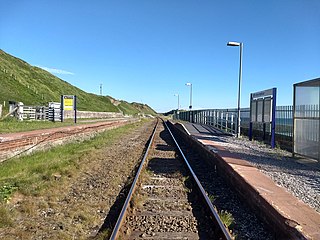
Nethertown is a railway station on the Cumbrian Coast Line, which runs between Carlisle and Barrow-in-Furness. The station, situated 39 miles (63 km) north-west of Barrow-in-Furness, serves the village of Nethertown in Cumbria. It is owned by Network Rail and managed by Northern Trains.
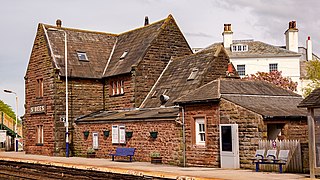
St Bees is a railway station on the Cumbrian Coast Line, which runs between Carlisle and Barrow-in-Furness. The station, situated 44+1⁄2 miles (72 km) south-west of Carlisle, serves the village of St Bees in Cumbria. It is owned by Network Rail and managed by Northern Trains.

Workington is a railway station on the Cumbrian Coast Line, which runs between Carlisle and Barrow-in-Furness. The station, situated 33 miles (53 km) south-west of Carlisle, serves the town of Workington in Cumbria. It is owned by Network Rail and managed by Northern Trains.

Askam is a railway station on the Cumbrian Coast Line, which runs between Carlisle and Barrow-in-Furness. The station, situated 6 miles (10 km) north of Barrow-in-Furness, serves the villages of Askam-in-Furness and Ireleth in Cumbria. It is owned by Network Rail and managed by Northern Trains.
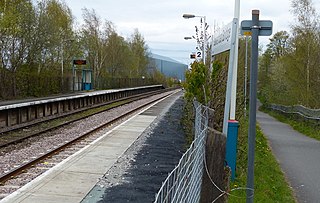
Hawarden Bridge railway station is a railway station near Shotton, Flintshire, Wales. It is situated on the Borderlands Line 13 miles (21 km) north of Wrexham Central, on the north side of Hawarden Bridge over the River Dee. The station and all trains serving it are operated by Transport for Wales.

Allens West is a railway station on the Tees Valley Line, which runs between Bishop Auckland and Saltburn via Darlington. The station, situated 8 miles 9 chains east of Darlington, serves the town of Eaglescliffe, Borough of Stockton-on-Tees in County Durham, England. It is owned by Network Rail and managed by Northern Trains.

Bentham is a railway station on the Bentham Line, which runs between Leeds and Morecambe via Skipton. The station, situated 19 miles (31 km) east of Lancaster, serves the town of High Bentham and surrounding settlements in North Yorkshire. It is owned by Network Rail and managed by Northern Trains.

Abererch railway station is located at a level crossing on the minor road from the beach to the village of Abererch on the Llŷn Peninsula in Gwynedd, Wales.

Elsenham railway station is on the West Anglia Main Line serving the village of Elsenham in Essex, England. It is 35 miles 45 chains (57.2 km) down the line from London Liverpool Street and is situated between Stansted Mountfitchet and Newport stations. Its three-letter station code is ESM.

Tackley railway station is on the Cherwell Valley Line in Oxfordshire, England, serving the village of Tackley and its surrounding area. Great Western Railway operates the station and all but one of the trains serving it. The exception is a weekday late night service to Banbury operated by Chiltern Railways.

Lydd Town was a railway station which served the town of Lydd in Kent, England. Opened on 7 December 1881 by The Lydd Railway Company. It closed to passengers in 1967 but the line through the station remained open for freight.

There are around 6,000 level crossings in the United Kingdom, of which about 1,500 are public highway crossings. This number is gradually being reduced as the risk of accidents at level crossings is considered high. The director of the UK Railway Inspectorate commented in 2004 that "the use of level crossings contributes the greatest potential for catastrophic risk on the railways." The creation of new level crossings on the national network is banned, with bridges and tunnels being the more favoured options. The cost of making significant reductions, other than by simply closing the crossings, is substantial; some commentators argue that the money could be better spent. Some 5,000 crossings are user-worked crossings or footpaths with very low usage. The removal of crossings can improve train performance and lower accident rates, as some crossings have low rail speed limits enforced on them to protect road users. In fact, between 1845 and 1933, there was a 4 miles per hour (6.4 km/h) speed limit on level crossings of turnpike roads adjacent to stations for lines whose authorising Act of Parliament had been consolidated in the Railways Clauses Consolidation Act 1845 although this limit was at least sometimes disregarded.
References
- 1 2 3 Quick, Michael (2009) [2001]. Railway passenger stations in Great Britain: a chronology (4th ed.). Oxford: Railway & Canal Historical Society. p. 420. ISBN 978-0-901461-57-5. OCLC 612226077.
- ↑ Joy, David (1990). A Regional History of the Railways of Great Britain. Vol. 14: The Lake Counties (2nd ed.). Newton Abbott, Devon: David & Charles. p. 134. ISBN 0 946537 56 9.
- 1 2 3 4 Parkin, Dave (Spring 2008). "The Airship Station that never was" (PDF). Dirigible. No. 53. Airship Heritage Trust. pp. 6–8.
- ↑ Pat Rowland. "Ravenstown" (PDF).
- ↑ Barrow District - Wraysholme halt. Proposed reconstruction of platforms (Report). Barrow-in-Furness County Borough Council. 1937.
- ↑ "Killed on the Furness Railway" . Soulby's Ulverston Advertiser and North Lonsdale Advertiser. No. 3025. 9 August 1906. p. 7 – via British Newspaper Archive.
- ↑ Rail Accident Report: Fatal accident at Wraysholme crossing, Flookburgh, Cumbria; 3 November 2008 (PDF) (Report). Rail Accident Investigation Branch. 2008.
- ↑ "Reducing the risk from automatic level crossings". Rail Engineer. 22 March 2018. Retrieved 13 March 2018.